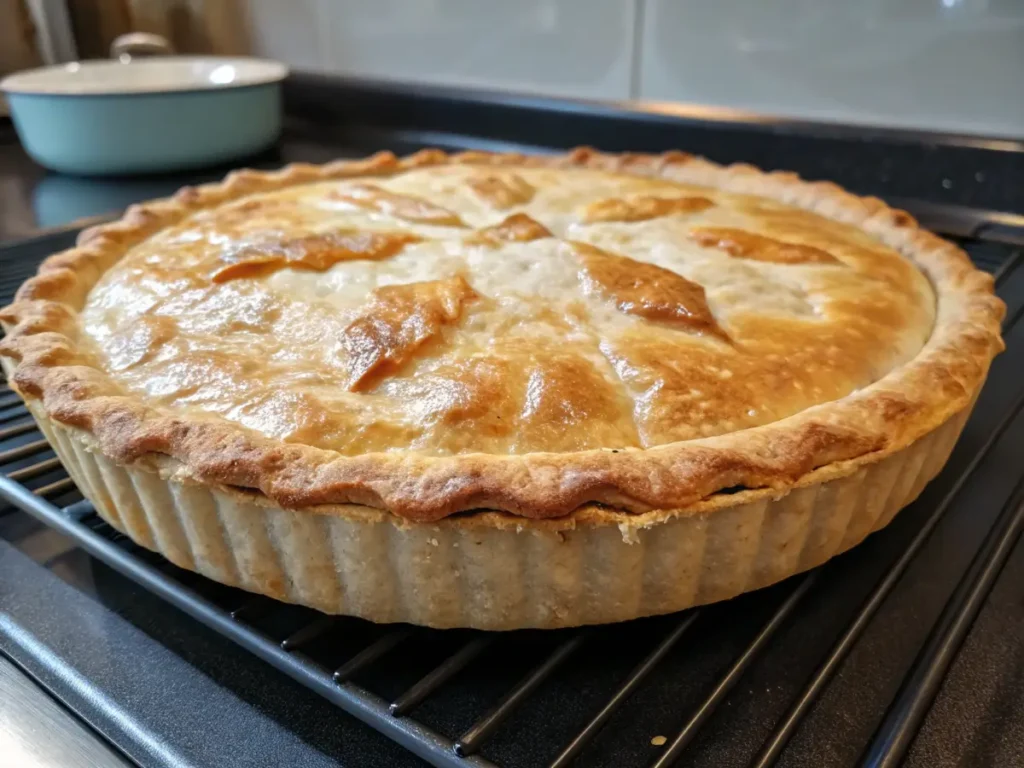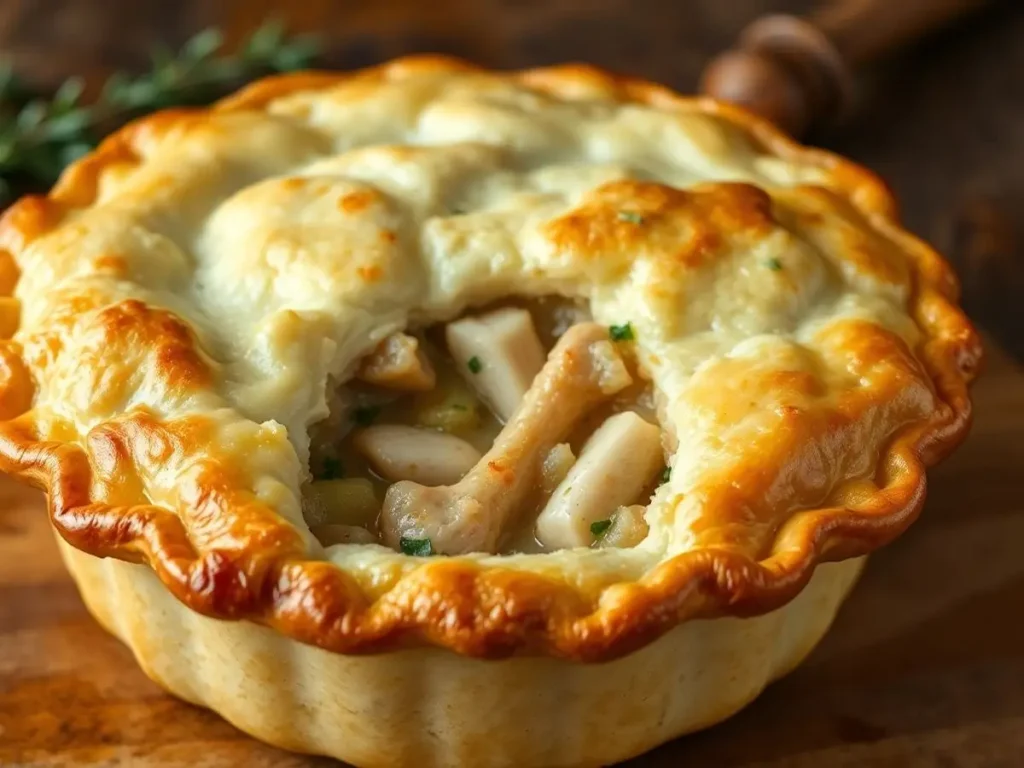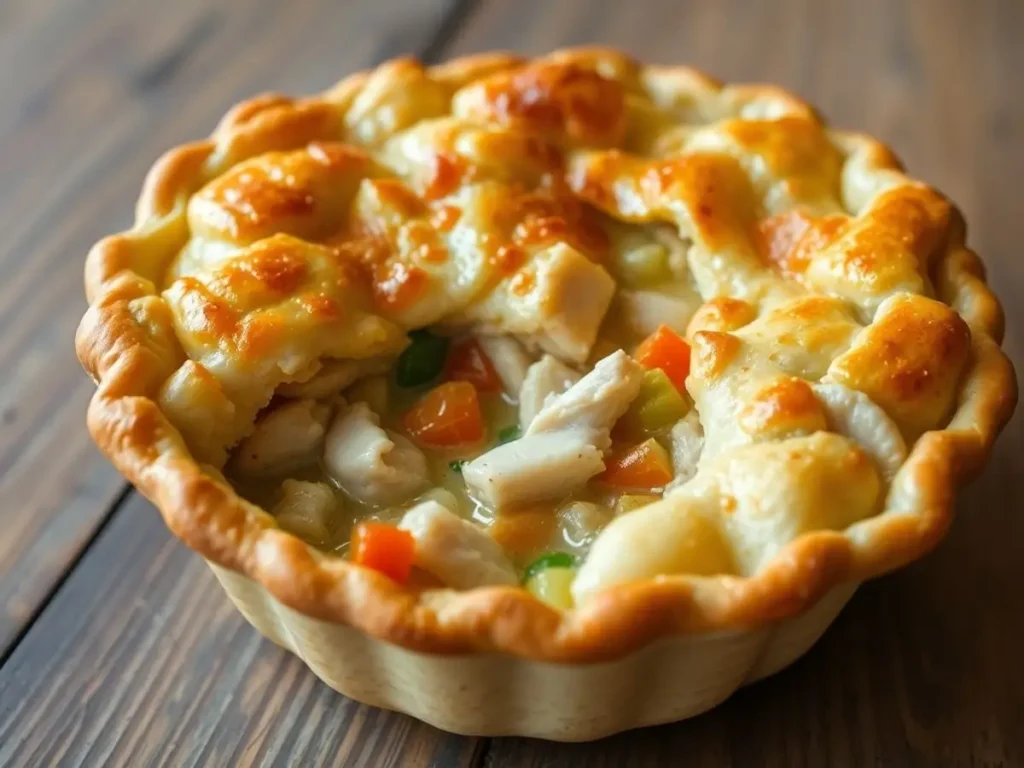
Ever tried making chicken pot pie and ended up with a soggy bottom crust? It’s a common issue that can ruin a perfectly good meal. Some folks swear by prebaking the bottom crust to keep it crisp and delicious. But is it really necessary? Let’s explore the ins and outs of prebaking your chicken pot pie crust and see if it’s worth the extra step.
Table of Contents
Key Takeaways
- Prebaking can prevent a soggy bottom crust, making your chicken pot pie more enjoyable.
- Skipping prebaking might save time, but it risks a less crispy crust.
- Using pie weights during prebaking helps keep the crust flat and even.
- Alternatives like puff pastry or top-only crusts can simplify the process.
- Expert opinions vary, so experimenting might be the best way to find what works for you.
Understanding the Role of the Bottom Crust in Chicken Pot Pie
Why the Bottom Crust Matters
The bottom crust in a chicken pot pie isn’t just a structural component; it’s a critical part of the pie’s overall flavor and texture. A well-baked bottom crust provides a sturdy base that holds the delicious filling without turning into a soggy mess. Imagine biting into a slice of pot pie and enjoying the contrast between the crispy crust and the creamy filling. That’s the magic of a properly cooked bottom crust.
Common Issues with Bottom Crusts
Unfortunately, achieving the perfect bottom crust isn’t always easy. Many home cooks struggle with the dreaded soggy bottom, where the crust becomes too wet and loses its crispness. This can happen for several reasons:
- Filling is too watery, soaking into the crust.
- Oven temperature isn’t high enough to properly cook the crust.
- The crust isn’t pre-baked, leading to undercooking.
Each of these issues can ruin what could have been a perfect pot pie.
The Impact of a Soggy Bottom
A soggy bottom crust doesn’t just affect the texture; it can also alter the taste. When the crust absorbs too much moisture, it can become bland and doughy, overshadowing the flavors of the filling. Plus, it can make serving the pie a messy affair, as the crust falls apart when you try to cut a slice.
The bottom crust is more than just a container for your filling. It’s a key player in creating a delicious, balanced chicken pot pie.
Incorporating techniques like prebaking the crust or adjusting the filling consistency can help you avoid these pitfalls and achieve pot pie perfection every time.
The Science Behind Prebaking Your Chicken Pot Pie Crust
What is Prebaking?
Prebaking, also called blind baking, is when you bake the pie crust without any filling. This step is crucial to avoid the dreaded soggy bottom. By prebaking, you ensure a firm crust that holds up under the weight of the filling. It’s like giving your crust a head start, so it stays crisp and delicious even after the filling is added.
How Prebaking Affects Texture
When you prebake, the heat works its magic on the dough. The result is a crust that’s not just cooked, but perfectly crisp. This process allows the dough to set, creating a barrier that prevents the filling’s moisture from seeping in. The texture becomes flaky and robust, adding a satisfying crunch to every bite.
The Chemistry of a Crisp Crust
The secret to a crisp crust lies in the chemistry of baking. As the dough bakes, the butter within melts, creating pockets of steam. These pockets puff up, giving the crust its flaky layers. Additionally, the heat causes the proteins and starches to set, forming a firm structure. Prebaking enhances this process, ensuring your crust is not just a vessel for the filling, but a star in its own right.
Prebaking transforms your chicken pot pie from ordinary to extraordinary, ensuring every slice delivers the perfect balance of crust and filling.
Step-by-Step Guide to Prebaking Your Chicken Pot Pie Crust
Gathering Your Ingredients
Before you start, make sure you have everything ready. You’ll need your pie dough, some pie weights or dried beans, and an egg for the wash. It’s also handy to have parchment paper and a fork. Having all your ingredients prepped saves time and stress.
Preparing the Crust for Prebaking
- Roll out your dough to fit your pie pan. Make sure it’s not too thin or too thick.
- Lay the dough in the pan and press it gently to fit the edges.
- Cover the dough with parchment paper and fill it with pie weights. This stops it from puffing up.
- Pop it in a preheated oven at 375°F and let it bake for about 15 minutes.
- Remove the weights and parchment, then bake for another 5 minutes until it’s lightly golden.
Tips for Perfect Prebaking
- Chill your dough before rolling it out. Cold dough helps keep it flaky.
- Use an egg wash after prebaking to seal the crust. This creates a barrier against moisture, keeping it crisp.
- Don’t skip the pie weights. They prevent bubbles and ensure an even bake.
Prebaking your crust might seem like an extra step, but it makes all the difference in achieving that perfect, non-soggy bottom crust. Trust the process, and your chicken pot pie will thank you with every bite.
Alternatives to Prebaking the Bottom Crust
Using Puff Pastry Instead
Switching out the traditional crust for puff pastry can be a game-changer. Puff pastry offers a light, flaky texture that complements the hearty chicken filling beautifully. It’s a breeze to work with, and you can find it ready-made at most grocery stores. Simply roll it out, place it over your pie, and let the oven do the rest. One tip: keep an eye on it to ensure it doesn’t brown too quickly.
Opting for a Top-Only Crust
If you’re not a fan of dealing with a bottom crust, why not go for a top-only crust? This approach saves time and effort, and it still delivers that satisfying crunch. You can use a traditional dough or even a biscuit topping for a rustic feel. Just prepare your chicken filling, pour it into your dish, and cover with your chosen topping. It’s a simple way to enjoy all the flavors without the fuss.
Exploring Non-Crust Toppings
For those looking to shake things up, consider non-crust toppings. Mashed potatoes or a cauliflower mash can provide a creamy contrast to the savory filling. These alternatives are especially great if you’re watching your flour intake. Plus, they add a unique twist to the classic pot pie, making it a versatile dish for any occasion.
Thinking outside the box with your chicken pot pie can lead to delightful surprises. Whether you choose puff pastry, a top-only crust, or a creative topping, each option brings its own charm to the table.
Remember, there’s no one “right” way to make a chicken pot pie. With a bit of salt and creativity, you can craft a dish that’s perfect for your taste buds.
Expert Opinions on Prebaking Chicken Pot Pie Crusts
Chef Insights on Crust Techniques
When it comes to achieving the perfect pot pie, chefs agree that the pastry crust can make or break the dish. Many chefs recommend prebaking, or “blind baking,” the bottom crust to avoid the dreaded soggy bottom. This technique involves baking the crust without the filling, which helps it crisp up before the moist filling is added. Chef Jamie Oliver suggests using pie weights or dried beans to keep the crust flat during this process.
Baker Tips for Avoiding Soggy Bottoms
Bakers have a few tricks up their sleeves to combat soggy crusts. One popular method is to brush the prebaked crust with an egg wash, creating a barrier that helps keep moisture at bay. Additionally, ensuring that the filling is not overly liquidy can prevent the crust from becoming soggy. Some bakers also recommend using a thicker filling, which naturally contains less moisture.
Professional Recommendations
Professionals in the culinary world often emphasize the importance of ingredient choice. For instance, using cold butter can result in a flakier crust, as opposed to warm butter, which tends to make the crust denser. Lard is considered by some to be the best fat for achieving the flakiest crust. Furthermore, experts advise against overworking the dough, as this can make it tough.
Prebaking might seem like an extra step, but it can elevate your chicken pot pie to a whole new level of deliciousness. By taking the time to prepare your crust properly, you ensure that every bite is as delightful as the last.
Troubleshooting Common Chicken Pot Pie Crust Problems

Preventing Burnt Crusts
It’s all too easy to end up with a burnt crust while trying to ensure the filling cooks through. To avoid this, consider using a pie shield. If you don’t have one, make your own by cutting a 4-inch circle in the center of a square of aluminum foil and placing it loosely over the pie. This helps protect the edges from over-browning while allowing the center to cook evenly.
Avoiding Undercooked Fillings
One common issue with chicken pot pie is an undercooked filling, which can ruin the entire dish. To prevent this, ensure your filling is partially cooked before adding it to the crust. Simmer your mixture of chicken, potatoes, and vegetables until they’re just tender. This step ensures everything cooks evenly once inside the pie.
Fixing Leaky Pies
A leaky pie can be a real mess, often caused by not sealing the crusts properly. Pinch the top and bottom crusts together firmly to seal in the filling. You can also brush a bit of beaten egg along the edges before sealing to act as a glue. If you’re using a double crust, make sure to cut a few slits in the top to allow steam to escape, preventing the filling from bubbling over.
Mastering the art of chicken pot pie involves a bit of practice and attention to detail. With these tips, you’ll be able to tackle common crust problems and enjoy a delicious homemade pie every time.
Enhancing Flavor and Texture in Your Chicken Pot Pie

Incorporating Herbs and Spices
Adding the right herbs and spices can make or break your chicken pot pie. Fresh thyme, rosemary, and sage are classic choices that complement the savory flavor of the pie. A sprinkle of pepper can add a subtle kick, while a dash of nutmeg can bring warmth to the dish. Don’t forget to season your filling generously with salt to enhance the natural flavors of the vegetables and chicken.
Balancing Filling and Crust
Achieving the perfect balance between filling and crust is essential. Too much filling can lead to a soggy bottom, while too little can make the pie feel dry. Aim for a filling that is rich in ingredients like chicken, carrots, and celery, all simmered in a creamy mix of chicken broth and milk. This not only adds flavor but also ensures a satisfying bite with every forkful.
Achieving the Perfect Bake
The key to a perfect bake lies in both oven temperature and timing. First, preheat your oven to medium heat so that the pie cooks evenly. Next, place the pie in the oven and bake until the crust turns a golden brown and the filling bubbles through the vents. By doing this, you ensure that the crust stays flaky while the filling is cooked to perfection. Furthermore, remember that a well-baked pie has tender vegetables and a crust that is both crisp and tender.
Final Thoughts
So, should you prebake the bottom crust of a chicken pot pie? Well, it really depends on what you’re after. If you’re all about that crispy, golden base, then prebaking is your friend. It helps keep the crust from getting soggy when you add the filling. But if you’re in a hurry or just not too fussed about the bottom crust, you might skip it. Either way, the pot pie will still be a comforting, delicious meal. Just remember, cooking is all about what works for you and your taste buds. So, give it a try and see what you like best!
Frequently Asked Questions
Why is the bottom crust important in a chicken pot pie?
The bottom crust holds the filling and adds to the overall flavor and texture of the pie.
What problems can happen with the bottom crust?
Common issues include sogginess or undercooking, which can make the pie less enjoyable.
How does prebaking the crust help?
Prebaking, or blind baking, helps make the crust crispier and prevents it from getting soggy.
What is an alternative to prebaking the bottom crust?
You can use puff pastry or just have a top crust to avoid dealing with a soggy bottom.
What are some expert tips for a perfect pie crust?
Experts recommend blind baking and using pie weights to keep the crust from puffing up.
How can I improve the flavor of my chicken pot pie?
Adding herbs and spices to the filling can enhance the taste and make the pie more delicious.
